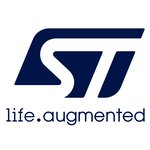Mbed OS Device Management example for various ST boards.
DEPRECATED
This example application is not maintained and not recommended. It uses an old version of Mbed OS, Pelion DM and Arm toolchain. It doesn't work with Mbed Studio.
Please use: https://os.mbed.com/teams/mbed-os-examples/code/mbed-os-example-pelion/
This example is known to work great on the following platforms:
- DISCO_L475E_IOT01A - onboard WiFI and onboard QSPI flash. Board specific example using onboard sensors is available here.
- DISCO_F413H - onboard WiFI and onboard QSPI flash.
- DISCO_F469NI - WizFi310 WiFI shield and onboard QSPI flash (see WiFi shield instructions).
- DISCO_F746NG - onboard Ethernet and using onboard QSPI flash.
- DISCO_F769NI - onboard Ethernet and using onboard QSPI flash.
- DISCO_L496AG - WizFi310 WiFI shield and onboard QSPI flash (see WiFi shield instructions).
- NUCLEO_F207ZG - onboard Ethernet and wired SD card (SD card wiring instructions).
- NUCLEO_F412ZG - WizFi310 WiFI shield and SD card shield (see WiFi shield instructions).
- NUCLEO_F429ZI - onboard Ethernet and wired SD card (SD card wiring instructions).
- NUCLEO_F746ZG - onboard Ethernet and wired SD card (SD card wiring instructions).
- NUCLEO_F767ZI - onboard Ethernet and wired SD card (SD card wiring instructions).
- NUCLEO_L476RG - WizFi310 WiFI shield and SD card shield (see WiFi shield instructions).
- NUCLEO_L496ZG - WizFi310 WiFI shield and SD card shield (see WiFi shield instructions).
- NUCLEO_L4R5ZI - WizFi310 WiFI shield and SD card shield (see WiFi shield instructions).
Follow the Quick-Start instructions: https://cloud.mbed.com/quick-start
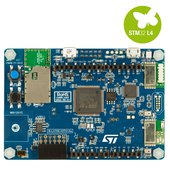
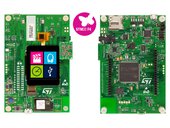

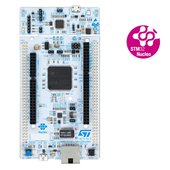
Example functionality
This example showcases the following device functionality:
- Read ADC temperature and ADC vref, and report them as Pelion LWM2M resources (see image below).
- On user button click, increment Pelion LWM2M button resource.
- Allow the user to change the state of the board LED from Pelion LWM2M led_state resource and PUT request.
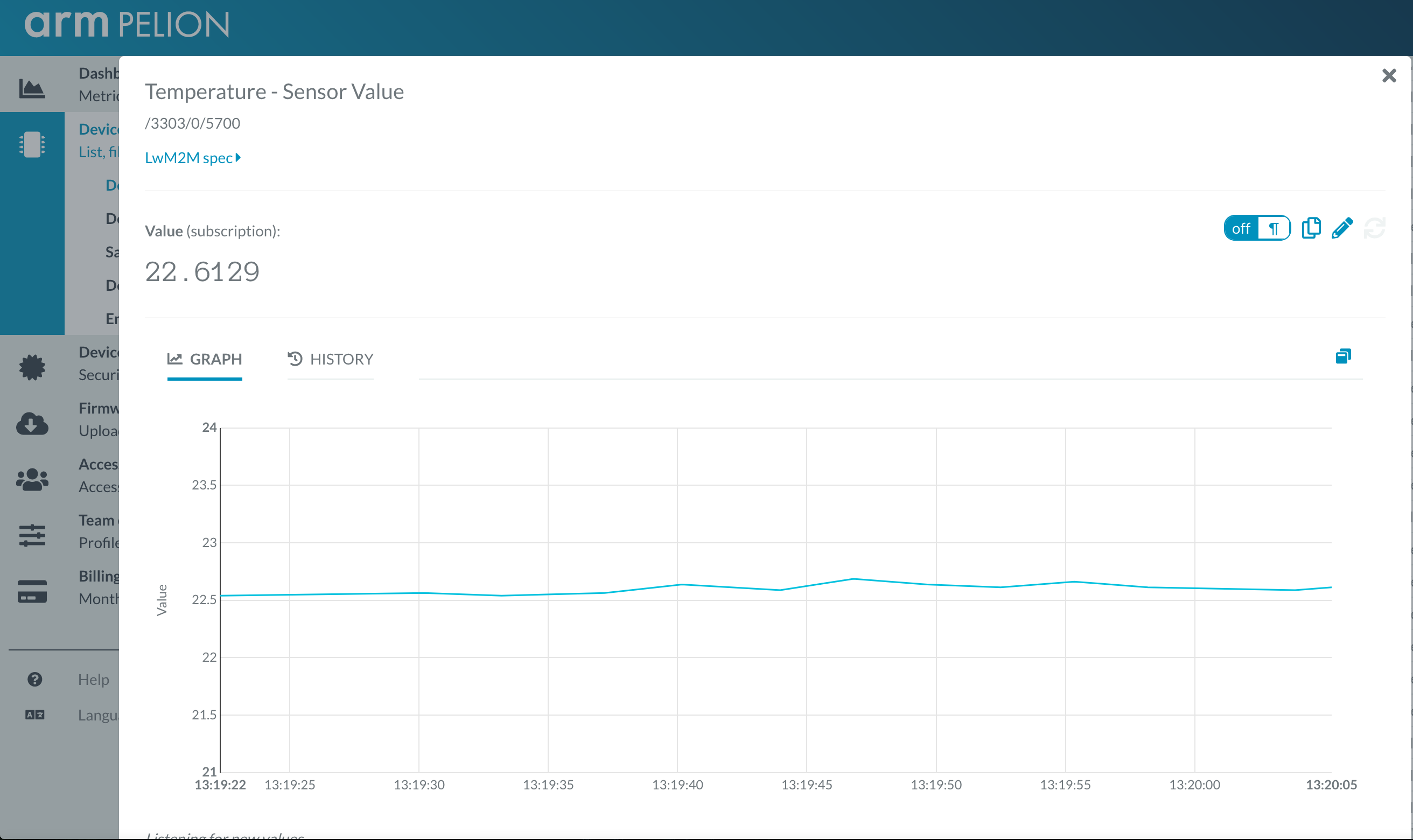
SD card wiring
The ST Nucleo family of boards don't have storage onboard and therefore you will need an SD card. A limitation on ST Nucleo 144 boards is that there's a conflict between Ethernet and SPI pins on Arduino D11. Due to this, the SD card must be wired to different SPI bus that doesn't conflict with other functionality. The image below provide instructions on how to wire an SD card to a non-conflicting SPI instance.
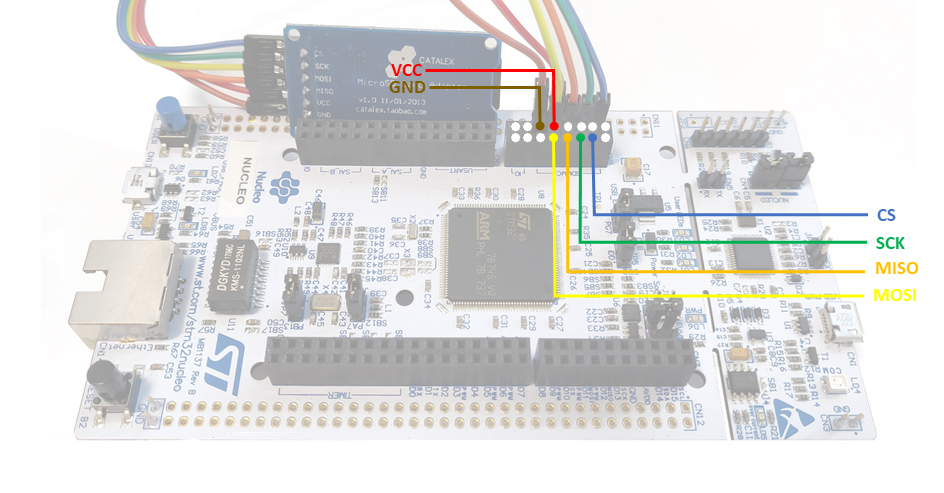
If you are not a first-time Pelion Device Management user your device's SD card may already have connect and update certificates on it. If this is the case, remove and manually format your micro SD card, flash the binary to the device and then re-insert your micro SD card.
WiFi shield setup/wiring
Some ST Nucleo and Discovery boards don't have IP connectivity option, but bundled with a WiFi shield, they can take benefit of full device management capabilities. See links to reference images below on how to wire WizFI310 WiFi shield and/or SD card shield:
- ST DISCO_F469NI + WizFi310 WiFi Shield
- ST DISCO_L496AG + WizFi310 WiFi Shield
- ST NUCLEO_F412ZG + WizFi310 WiFi Shield + SD card shield
- ST NUCLEO_L476RG + WizFi310 WiFi Shield + SD card shield
- ST NUCLEO_L496ZG + WizFi310 WiFi Shield + SD card shield
- ST NUCLEO_L4R5ZI + WizFi310 WiFi Shield + SD card shield
Use this example with Mbed CLI
1. Import the application into your desktop:
mbed import /teams/ST/code/pelion-example-common cd pelion-example-common
2. Install the CLOUD_SDK_API_KEY
mbed config -G CLOUD_SDK_API_KEY <PELION_DM_API_KEY>
For instructions on how to generate your API key, please see the documentation.
3. Initialize firmware credentials (done once per repository). You can use the following command:
mbed dm init -d "<your company name in Pelion DM>" --model-name "<product model identifier>" -q --force
If above command do not work for your Mbed CLI, please consider upgrading Mbed CLI to version 1.8.x or above.
4. Compile and program:
mbed compile -t <toolchain> -m <TARGET_BOARD>
(supported toolchains : GCC_ARM / ARM / IAR)
Diff: main.cpp
- Revision:
- 7:24d524c2bdcc
- Parent:
- 5:766c011942b4
- Child:
- 8:579904ba4ba1
--- a/main.cpp Sun Dec 16 11:58:40 2018 +0000
+++ b/main.cpp Sun Dec 16 12:02:30 2018 +0000
@@ -29,18 +29,24 @@
// Default network interface object
NetworkInterface *net = NetworkInterface::get_default_instance();
-// Default block device
+// Default block device available on the target board
BlockDevice *bd = BlockDevice::get_default_instance();
-SlicingBlockDevice sd(bd, 0, 2*1024*1024);
-LittleFileSystem fs("fs", &sd);
+
+#if COMPONENT_SD || COMPONENT_NUSD
+// Use FATFileSystem for SD card type blockdevices
+FATFileSystem fs("fs", bd);
+#else
+// Use LittleFileSystem for non-SD block devices to enable wear leveling and other functions
+LittleFileSystem fs("fs", bd);
+#endif
// Default User button for GET example
InterruptIn button(BUTTON1);
// Default LED to use for PUT/POST example
DigitalOut led(LED1);
-// Default temperature reading from microcontroller
+// Temperature reading from microcontroller
AnalogIn adc_temp(ADC_TEMP);
-// Voltage reference from microcontroller
+// Voltage reference reading from microcontroller
AnalogIn adc_vref(ADC_VREF);
#define SENSORS_POLL_INTERVAL 1.0
@@ -99,7 +105,7 @@
* @param endpoint Information about the registered endpoint such as the name (so you can find it back in portal)
*/
void registered(const ConnectorClientEndpointInfo *endpoint) {
- printf("Connected to Pelion Device Management. Endpoint Name: %s\n", endpoint->internal_endpoint_name.c_str());
+ printf("Registered to Pelion Device Management. Endpoint Name: %s\n", endpoint->internal_endpoint_name.c_str());
endpointInfo = endpoint;
}
@@ -122,14 +128,19 @@
printf("Starting Simple Pelion Device Management Client example\n");
// If the User button is pressed ons start, then format storage.
+ DigitalIn *user_button = new DigitalIn(BUTTON1);
+#if TARGET_DISCO_L475VG_IOT01A
+ // The user button on DISCO_L475VG_IOT01A works the other way around
+ const int PRESSED = 0;
+#else
const int PRESSED = 1;
- DigitalIn *user_button = new DigitalIn(BUTTON1);
+#endif
if (user_button->read() == PRESSED) {
printf("User button is pushed on start. Formatting the storage...\n");
- int storage_status = fs.reformat(&sd);
+ int storage_status = fs.reformat(bd);
if (storage_status != 0) {
- if (sd.erase(0, sd.size()) == 0) {
- if (fs.format(&sd) == 0) {
+ if (bd->erase(0, bd->size()) == 0) {
+ if (fs.format(bd) == 0) {
storage_status = 0;
printf("The storage reformatted successfully.\n");
}
@@ -161,6 +172,8 @@
printf("Connected to the network successfully. IP address: %s\n", net->get_ip_address());
+ printf("Initializing Pelion Device Management Client...");
+
// SimpleMbedCloudClient handles registering over LwM2M to Pelion DM
SimpleMbedCloudClient client(net, bd, &fs);
int client_status = client.init();
@@ -200,7 +213,7 @@
// Register with Pelion DM
client.register_and_connect();
- int i = 600; // wait 60 seconds
+ int i = 600; // wait up 60 seconds before attaching sensors and button events
while (i-- > 0 && !client.is_client_registered()) {
wait_ms(100);
}
